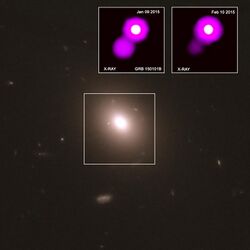Astronomy:GRB 150101B
 Detection of GRB150101B | |
| Spectral class | ?? GRB, short-duration[1] |
|---|---|
| Date | 1 January 2015[1] 15:23 UT by the Burst Alert Telescope (BAT);[1] 15:23:35 UT by the Gamma-ray Burst Monitor (GBM)[1] |
| Constellation | Virgo[2][3] |
| Right ascension | 12h 32m 04.96s[2] |
| Declination | −10° 56′ 00.7″[2] |
| Epoch | J2000[1] |
| Galactic coordinates | 295.26103 +51.64971 [ 1800 1800 0 ][4] |
| Distance | 1.7 billion light-years (0.52 Gpc)[1] z=0.13437;[1] 0.1341[2] |
| Redshift | ?? 0.093[4] |
| Total energy output | ~1.3 ×1049 ergs[1] |
GRB 150101B is a gamma-ray burst (GRB) that was detected on 1 January 2015 at 15:23 UT by the Burst Alert Telescope (BAT) on board the Swift Observatory Satellite, and at 15:23:35 UT by the Gamma-ray Burst Monitor (GBM) on board the Fermi Gamma-ray Space Telescope.[1] The GRB was determined to be 1.7 billion light-years (0.52 Gpc) from Earth near the host galaxy 2MASX J12320498-1056010 [4] in the constellation Virgo.[2][3] The characteristics of GRB 150101B are remarkably similar to the historic event GW170817, a merger of neutron stars.[2][5][6][7]
Observations
In October 2018, astronomers reported that GRB 150101B, 1.7 billion light years away from Earth, may be analogous to the historic GW170817, a gravitational wave detected in 2017, which is about 130 million light years away, and associated with the merger of two neutron stars. The similarities between the two events, in terms of gamma ray, optical and x-ray emissions, as well as to the nature of the associated host galaxies, are considered "striking", and this remarkable resemblance suggests the two separate and independent events may both be the result of the merger of neutron stars, and both may be a hitherto-unknown class of kilonova transients. Kilonova events, therefore, may be more diverse and common in the universe than previously understood, according to the researchers.[2][5][6][7][8]
According to one of the study researchers, Eleonora Troja, “It’s a big step to go from one detected object to two. Our discovery tells us that events like GW170817 and GRB 150101B could represent a whole new class of erupting objects that turn on and off in X-rays and might actually be relatively common.”[9] Troja further stated, “We’ve been able [to] identify this kilonova without gravitational wave data, so maybe in the future, we’ll even be able to do this without directly observing a gamma-ray burst.”[10] Another researcher, Geoffrey Ryan, said,“We have a case of cosmic look-alikes. They look the same, act the same and come from similar neighborhoods, so the simplest explanation is that they are from the same family of objects.”[9] According to co-author, Alexander Kutyrev, “If the next such observation reveals a merger between a neutron star and a black hole, that would be truly groundbreaking. Our latest observations give us renewed hope that we’ll see such an event before too long.”[10] Another researcher, Hendrik Van Eerten, noted, “We need more cases like GW170817 that combine gravitational wave and electromagnetic data to find an example between a neutron star and black hole. Such a detection would be the first of its kind. Our results are encouraging for finding more mergers and making such a detection."[9]
See also
References
- ↑ 1.0 1.1 1.2 1.3 1.4 1.5 1.6 1.7 1.8 Burns, E.; Veres, P.; Connaughton, V.; Racusin, J.; Briggs, M. S.; Christensen, N.; Goldstein, A.; Hamburg, R. et al. (2018-08-17). "Fermi GBM Observations of GRB 150101B: A Second Nearby Event with a Short Hard Spike and a Soft Tail". The Astrophysical Journal 863 (2): L34. doi:10.3847/2041-8213/aad813. ISSN 2041-8213.
- ↑ 2.0 2.1 2.2 2.3 2.4 2.5 2.6 Staff (16 October 2018). "All in the Family: Kin of Gravitational-Wave Source Discovered". Harvard University. http://chandra.harvard.edu/photo/2018/kilonova/. Retrieved 17 October 2018.
- ↑ 3.0 3.1 Staff. "Finding the constellation which contains given sky coordinates". DJM.cc. http://djm.cc/constellation.html. Retrieved 17 October 2018.
- ↑ 4.0 4.1 4.2 Staff (17 October 2018). "GRB 150101B". SIMBAD. http://simbad.u-strasbg.fr/simbad/sim-basic?Ident=GRB+150101B. Retrieved 17 October 2018.
- ↑ 5.0 5.1 University of Maryland (16 October 2018). "All in the family: Kin of gravitational wave source discovered - New observations suggest that kilonovae -- immense cosmic explosions that produce silver, gold and platinum--may be more common than thought". EurekAlert!. https://www.eurekalert.org/pub_releases/2018-10/uom-ait101518.php. Retrieved 17 October 2018.
- ↑ 6.0 6.1 Troja, E. (16 October 2018). "A luminous blue kilonova and an off-axis jet from a compact binary merger at z = 0.1341". Nature Communications 9 (4089 (2018)): 4089. doi:10.1038/s41467-018-06558-7. PMID 30327476. Bibcode: 2018NatCo...9.4089T.
- ↑ 7.0 7.1 Mohon, Lee (16 October 2018). "GRB 150101B: A Distant Cousin to GW170817". NASA. https://www.nasa.gov/mission_pages/chandra/images/grb-150101b-a-distant-cousin-to-gw170817.html. Retrieved 17 October 2018.
- ↑ Wall, Mike (17 October 2018). "Powerful Cosmic Flash Is Likely Another Neutron-Star Merger". Space.com. https://www.space.com/42158-another-neutron-star-crash-detected.html. Retrieved 17 October 2018.
- ↑ 9.0 9.1 9.2 Staff (17 October 2018). "Astronomers Find Object with Remarkable Similarities to Neutron-Star Merger GW170817". Sci-News.com. http://www.sci-news.com/astronomy/kilonova-grb-150101b-06512.html. Retrieved 17 October 2018.
- ↑ 10.0 10.1 Klesman, Alison (17 October 2018). "Another neutron star merger may have been spotted - An event that looks suspiciously like the one that produced gravitational waves in 2017 hints that mergers between neutron stars and other exotic objects may be easier to find than we'd thought.". Astronomy. http://astronomy.com/news/2018/10/a-second-neutron-star-merger-may-have-been-spotted. Retrieved 17 October 2018.
External links
- "GRB 150101B". SIMBAD. Centre de données astronomiques de Strasbourg. http://simbad.u-strasbg.fr/simbad/sim-basic?Ident=GRB+150101B.
 |

